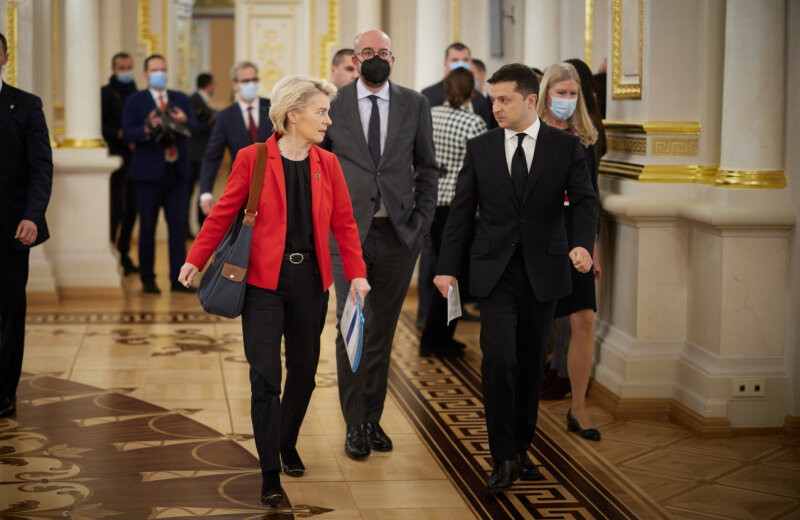Ukraine and the European Union have agreed to unite their airspace during an Oct. 12 summit in Kyiv, completing 15 years of negotiations.
The Common Civil Aviation Area Agreement, widely known as the Open Skies Treaty, is expected to open Ukraine up to more low-cost air routes and boost tourism, thanks to the mandatory implementation of European standards and rules in the field of air transportation.
Removing market restrictions should boost social, economic and tourism cooperation between the EU and Ukraine, both sides believe.
“The EU remains Ukraine’s closest friend,” President of the European Council Charles Michel said during the summit.
The treaty allows Ukrainian and European low-cost airlines to fly above Ukraine and Europe without restrictions. Previously, airlines needed the approval of the government to start a flight. This process was time-consuming and bureaucratic, experts said.
Under the new agreement, foreign airlines can fly between Ukrainian cities and schedule as many flights as they like. Ukrainian airlines, in turn, could fly between European airports but have to start and finish their flights in Ukraine.
The deal is intended to foster competition which would bring down ticket prices. However, Ukrainian companies like Ukrainian International Airlines (UIA) worry that they can now be easily overwhelmed by foreign competitors.
“It means high standards of flight safety, new opportunities for citizens and businesses, more flights and wider geography of travel,” President Volodymyr Zelensky said during the Ukraine-EU summit in Kyiv’s Mariinsky Palace.
The agreement has to be ratified by all European Union member states. However, according to the Ministry of Infrastructure, the deal for Ukraine can be applied on a temporary basis while all signatures are collected.
The EU has similar open skies agreements with the United States, the Western Balkans, Morocco, Georgia, Jordan, Moldova and Israel.
Why did it take so long?
The process of creating a common EU aviation area began in 1999. On Dec. 12, 2006, the Council of the EU authorized Brussels to start formal negotiations with Ukraine. The text of the Common Aviation Agreement was agreed upon by the parties at the Eastern Partnership summit in Vilnius on Nov. 28, 2013. But due to foreign policy conditions, the signing was postponed indefinitely.
Ukraine has since been making agreements with each EU country individually. Gibraltar was the biggest stumbling block to Ukraine’s accession because of an international dispute between Spain and the United Kingdom that has lasted since the early 18th century.
After Brexit, the withdrawal of the UK from the EU in 2020, it was no longer an obstacle.
In June 2021, the European Council has allowed Ukraine, Armenia, Tunisia, and Qatar to adhere to the Open Skies agreement with the EU.
What is special about this agreement?
Ukraine has long sought an Open Skies deal with Brussels as it is seen as one of the country’s top priorities in the field of European integration. The agreement can be comparable to the Free Trade Area Agreement since it aims at establishing common standards and liberalizing the air transport market.
Before, Ukraine had bilateral air services agreements with each EU country, which set restrictions on the number of carriers and weekly flights. This made it difficult for new carriers to enter squeeze into popular slots.
The new agreement with the EU stipulates that restrictions on the number of carriers and flights will be lifted.
Also, Ukrainian passengers will receive additional rights and financial guarantees, as the EU protects passengers from flight cancelations and delays, regardless of the ticket price. In particular, the carrier must provide the passenger with food and a hotel if something went wrong and the flight could not depart.
In anticipation of the deal in September, European low-cost company Ryanair announced its intention to significantly expand into Ukraine and start working in almost half of the regional centers. According to its СEO, Michael O’Leary, the carrier wants to expand its presence in Ukraine as there are over 12 suitable airports for Ryanair in the country.
Irish low-cost carrier Ryanair, the largest in Europe, launched its first routes in Ukraine in 2018 and currently operates from five airports — Kyiv, Odesa, Kharkiv, Kherson and Lviv.
Ukrainian airlines oppose the deal
The Open Skies Treaty allows European airlines to operate domestic flights in Ukraine, while Ukrainian carriers in Europe will not receive such an opportunity.
Ukrainian airlines will be able to fly between different airports only if the start or end of the route is in Ukraine.
Yevhenii Dykhne, President of Ukrainian International Airlines (UIA), said that “Ukrainian airlines already endure discriminatory conditions,” which the agreement only worsened.
“It will add even more injustice to Ukrainian companies, as for some reason they have not received such preferences for flights between European cities,” Dykhne said in an interview with mintrans.news.
Unlike the rest of Europe, Ukraine and other Eastern European countries had protectionist aviation policies. Ryanair, for instance, had tried to enter Ukraine since 2013, but it wasn’t easy.
UIA had allegedly blocked Ryanair’s entry into the market to protect its own interests. Ukrainian oligarch Igor Kolomoisky is known to have a significant stake in the UIA.
Apart from the UIA, Ukrainians use other local airlines — Azur Air, SkyUp, Windrose, and Bees Airline. Among the popular foreign low-cost carriers that now fly to Ukraine are Ryanair, Hungarian WizzAir and Saudi Arabia’s Flynas.



